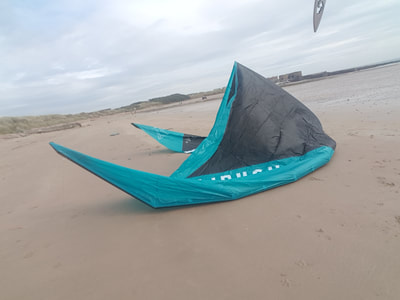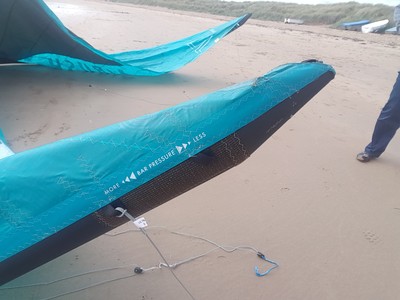17m Airush Ultra II (2019) Kite Review

Kites Tested
17m in 0-8 knots (day1) and 15-20 knots (day2)
Three Line Summary
Refined lightweight all-rounder
Out of the Bag
The Ultra II, as its name suggests is the second incarnation of Airush's all round, super lightweight single strutter.
Like the majority of the Airush range, it benefits from their load frame technology in addition to Technoforce D2 rip-stop - creating lightweight strength, durability and high performance.
There are a choice of bars on offer - The core bar with either strap or cleat de-power system, progression bar, access bar for small riders, or the uncluttered Ultra-specific bar, with large depower throw rather than a trim system. All bars come with low diameter tubing and a comfortable, hard-wearing grip; Brain quick release flagging the kite onto a single front line, heavy duty flying lines and integrated bar ends.
The kite comes in a surprisingly small bag, as it packs down to a space which I'd say most 9's would struggle to fit in. Making it a great kite for travel or simply just chucking over your shoulder with your other kit when you're not sure what the winds gonna do.
In the Air
The Ultra feels very refined in flight, with medium light bar pressure on the stock setting, which can be lightened further by changing the rear line connection option. Feedback is excellent and its surprisingly nimble for a 17m beast, perfectly at ease whether hooked in or unhooked.
The Ultra benefits from a pretty narrow diameter leading edge for a kite of this size, which see's it flying further forward than you'd expect for a large kite.
The kite generates good power when parked at the side of the window even in sub 10 knots, and when moved generates a good deal more! It turns quickly, and with the bar sheeted and there's power in the turns too!
On the water
On its first outing, the wind was light and the beach was deserted except for 2 friends on foil boards with foil kites - an ideal first test. The local weather station was reading 7 knots on average, so opted to take to the water with the slalom board. As shown in the video, the kite launched with ease and flew at the edge of the window without any trouble. Once on the water, a quick dive of the kite was plenty to get up on the board and going, and before long the board was blasting along at 20 knots or so. The long throw on the cleat bar gives plenty of room to decrease the power of the kite, despite the apparent wind being high at this speed.
On a couple of occasions, the wind died away to near zero, and i could see the nearby foil kites folding in half before falling out the sky. The Ultra coped with this very well, and whilst wasn't able to remain airborne, the more rigid structure of the ultra did seem to outlast the foils for a short time.
Relaunch on the Ultra is excellent; the central strut keeps the canopy clear of the water and the rounded leading edge causes it to slide across the water and rotate effortlessly into the relaunch position.
Whilst the bottom end of the ultra is excellent, I feel that the top end of a lightwind kite is almost as important, giving confidence to use it when the winds may pick up. The ultra has a very respectable top end, as the power can be dumped by sheeting the bar away/adjustment on the trim system. There is some wingtip flapping at high levels of depower, but this is to be expected on single strut kites.
On the second day of testing, the wind was very much stronger, probably outside of the intended windrange of the 17m, but it behaved very well and wasn't daunting in these conditions. It gave me a good opportunity to send it into some jumps, and I was very impressed with the floaty hangtime it produced, and its fast turning even permitted a downloop before landing - which is awesome for such a large kite.
I recently got the conditions to try it out for some freestyle; 8 gusting 14 knots according to the local weather station. The large size of the 17m means you need to be pretty aggressive with the bar to get it to turn fast, making it ideal for some wakestyle. In terms of pop it was very good considering its not designed for that, and with a reasonable amount of slack to get a bar passed without incident; I could do a back mobe on it without any bother :)
The smaller kite sizes may end up being less suitable for this particular endeavor, but the 17m is a marvelous kite for practicing tricks when you wouldn't be able to otherwise
Conclusions
The ultra is a kite which will appeal to a large majority. Its been designed as a freeride machine for recreational twintip riding, use in the surf and foiling, and its light yet strong construction yields many benefits; but it is its all round 'do anything' nature that makes it a real stand out kite for me. I also find it incredible that it fits in such a small bag, which you can just trivially chuck over your shoulder should the wind drop on any given session.
It's not often I find a kite which I can't fault, but for all-round performance across many disciplines & travelling I'd be surprised if you'd find a better kite.
For more info, check it out over at Airush
17m in 0-8 knots (day1) and 15-20 knots (day2)
Three Line Summary
Refined lightweight all-rounder
Out of the Bag
The Ultra II, as its name suggests is the second incarnation of Airush's all round, super lightweight single strutter.
Like the majority of the Airush range, it benefits from their load frame technology in addition to Technoforce D2 rip-stop - creating lightweight strength, durability and high performance.
There are a choice of bars on offer - The core bar with either strap or cleat de-power system, progression bar, access bar for small riders, or the uncluttered Ultra-specific bar, with large depower throw rather than a trim system. All bars come with low diameter tubing and a comfortable, hard-wearing grip; Brain quick release flagging the kite onto a single front line, heavy duty flying lines and integrated bar ends.
The kite comes in a surprisingly small bag, as it packs down to a space which I'd say most 9's would struggle to fit in. Making it a great kite for travel or simply just chucking over your shoulder with your other kit when you're not sure what the winds gonna do.
In the Air
The Ultra feels very refined in flight, with medium light bar pressure on the stock setting, which can be lightened further by changing the rear line connection option. Feedback is excellent and its surprisingly nimble for a 17m beast, perfectly at ease whether hooked in or unhooked.
The Ultra benefits from a pretty narrow diameter leading edge for a kite of this size, which see's it flying further forward than you'd expect for a large kite.
The kite generates good power when parked at the side of the window even in sub 10 knots, and when moved generates a good deal more! It turns quickly, and with the bar sheeted and there's power in the turns too!
On the water
On its first outing, the wind was light and the beach was deserted except for 2 friends on foil boards with foil kites - an ideal first test. The local weather station was reading 7 knots on average, so opted to take to the water with the slalom board. As shown in the video, the kite launched with ease and flew at the edge of the window without any trouble. Once on the water, a quick dive of the kite was plenty to get up on the board and going, and before long the board was blasting along at 20 knots or so. The long throw on the cleat bar gives plenty of room to decrease the power of the kite, despite the apparent wind being high at this speed.
On a couple of occasions, the wind died away to near zero, and i could see the nearby foil kites folding in half before falling out the sky. The Ultra coped with this very well, and whilst wasn't able to remain airborne, the more rigid structure of the ultra did seem to outlast the foils for a short time.
Relaunch on the Ultra is excellent; the central strut keeps the canopy clear of the water and the rounded leading edge causes it to slide across the water and rotate effortlessly into the relaunch position.
Whilst the bottom end of the ultra is excellent, I feel that the top end of a lightwind kite is almost as important, giving confidence to use it when the winds may pick up. The ultra has a very respectable top end, as the power can be dumped by sheeting the bar away/adjustment on the trim system. There is some wingtip flapping at high levels of depower, but this is to be expected on single strut kites.
On the second day of testing, the wind was very much stronger, probably outside of the intended windrange of the 17m, but it behaved very well and wasn't daunting in these conditions. It gave me a good opportunity to send it into some jumps, and I was very impressed with the floaty hangtime it produced, and its fast turning even permitted a downloop before landing - which is awesome for such a large kite.
I recently got the conditions to try it out for some freestyle; 8 gusting 14 knots according to the local weather station. The large size of the 17m means you need to be pretty aggressive with the bar to get it to turn fast, making it ideal for some wakestyle. In terms of pop it was very good considering its not designed for that, and with a reasonable amount of slack to get a bar passed without incident; I could do a back mobe on it without any bother :)
The smaller kite sizes may end up being less suitable for this particular endeavor, but the 17m is a marvelous kite for practicing tricks when you wouldn't be able to otherwise
Conclusions
The ultra is a kite which will appeal to a large majority. Its been designed as a freeride machine for recreational twintip riding, use in the surf and foiling, and its light yet strong construction yields many benefits; but it is its all round 'do anything' nature that makes it a real stand out kite for me. I also find it incredible that it fits in such a small bag, which you can just trivially chuck over your shoulder should the wind drop on any given session.
It's not often I find a kite which I can't fault, but for all-round performance across many disciplines & travelling I'd be surprised if you'd find a better kite.
For more info, check it out over at Airush
|
Kite Style
Struts Inflation Front connection Rear connection Tuning options Depower Safety Low End High End Bar Pressure Turning Freestyle Unhooked Upwind Boosting Relaunch |
Hybrid
1 One Pump (Single valve) Bridled with pulleys Direct 2 rear options Tested with cleat bar, but other options are available. Flag onto front line. Excellent Very Good Light/medium or light depending on setting Radial, fast for a 17m Very Good Very Good Very Good Very Good Excellent |







